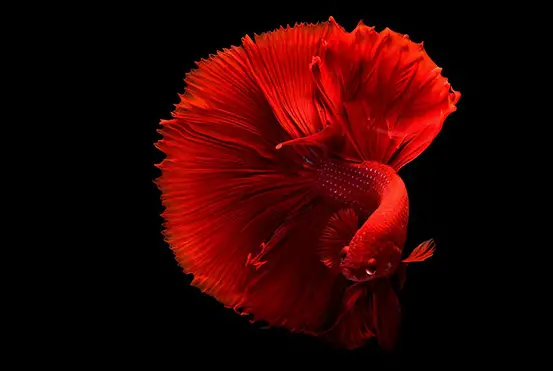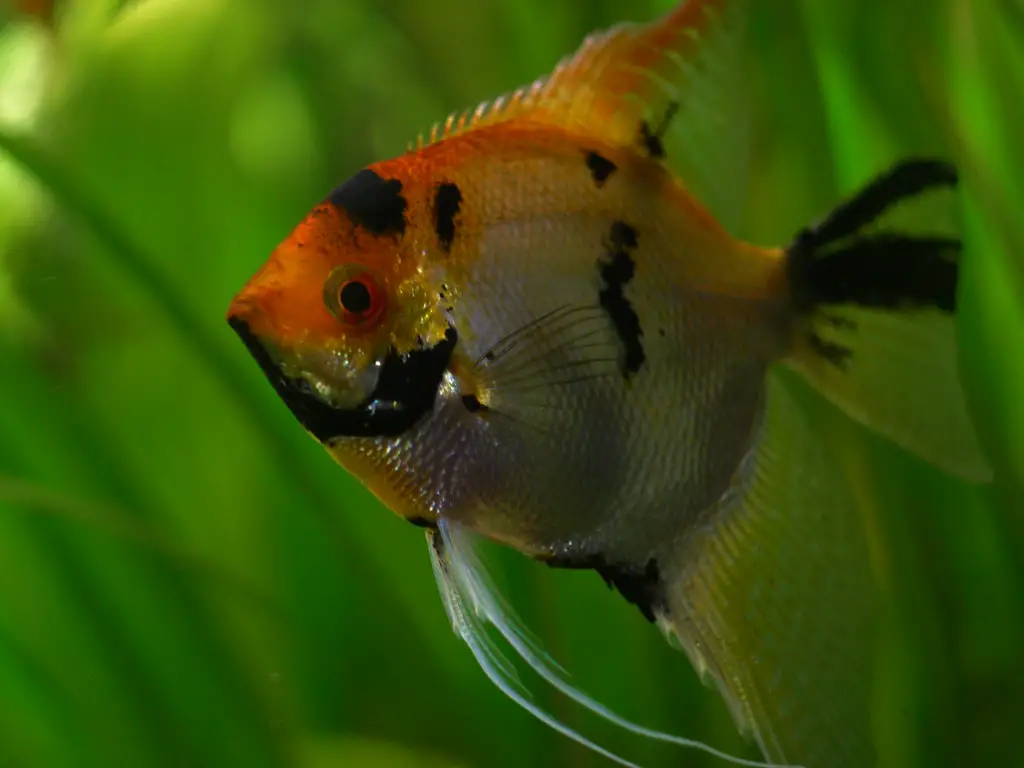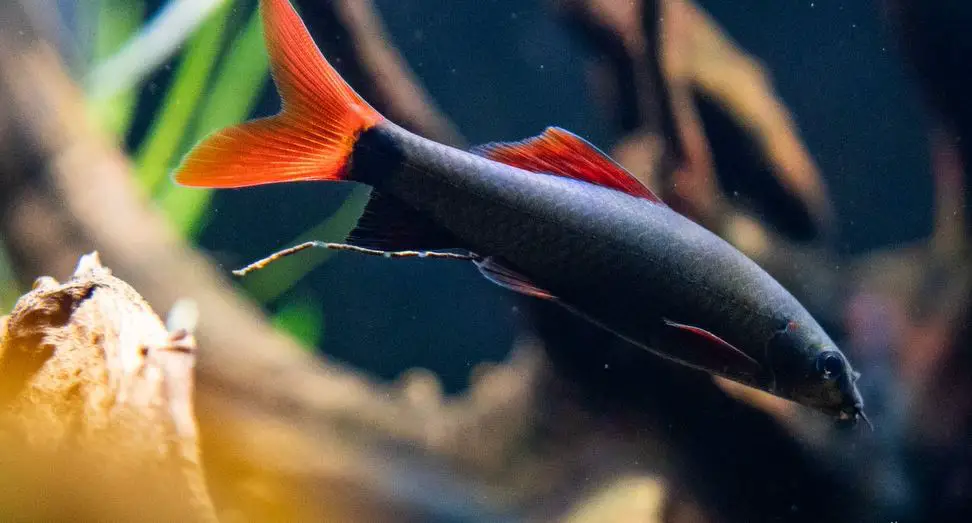Hardy, lively, peaceful yet active and fast, these are all words that describe a family of fish called the ‘Danio.’ Danio fish are active swimmers and hunter/predators, are small in size, and can grow up to approximately 2.5 inches.
Only six species of Danio, namely:- spotted, giant, pearl, rosy, White Clouded Minnow, and Zebra Danio, are available commonly. There are a total of 27 recognized species of Danio at present. These beautiful fish are, in turn, very easy to care for as well and can survive up to approximately five years. All you need to do is provide proper care and environment along with maintenance.
Today I will be briefing you on types of Danio and how you can properly take care of them.
Why Choose Danio?
Originating in Southeast Asia, Danio is a small scale tropical community fish. Therefore, Danio fish prefer an environment with current and long live plants. If you are in the hunt for a low budget operating tank then, Danio is a great fish to start with.
For readily available fish that are inexpensive as well as easy to raise, Danio is proven to be a good start for a beginner. A variety of Danio fish are easily available in different colors, shapes, and sizes: some with stripes, some with spots, and some even with barbs.
For a change, you can add various other species of fish along with your Danio.
Caring for Danio
Caring for your Danio has never been easier. Unlike some species, Danio is easy to care for, given you met all the requirements.
Danio is a tropical freshwater fish; therefore, here are a few things to watch out when creating a thriving environment on a budget :
Choosing the environment
Having the right environment for your fish can play a huge role in survival, as well as the visual aesthetic of your tank.
Talking about tanks, you need a more surface area for Danio. Therefore a long tank with artificially pumped current and live tall plants is the right condition for any Danio. You most certainly may not require a heated tank, for they are tropical and freshwater fish. Make sure when you set up your Danio tank, invest in a good filtration system.
The minimal requirement for housing a group of Danio is a tank with 25 gallon capacity with at least 5-6 Danios. You should never keep Danios alone. A 10-gallon capacity tank with 3 Danios is acceptable. However, I won’t recommend this. If you plan to have a school, then you will need a bigger capacity tank.
Water requirements
Water requirements for any fish start with pH, chemistry, temperature, and water changes. Diano is an ideal fish for beginners taking into consideration the variety of conditions it can thrive in.
The ideal pH to be maintained for a Danio is 7 to 7.8 pH level. The tropically originated species live at a temperature between 70 to 78° F (i.e., 21 to 25° C). Partial water changes should be done once a month, along with the substrate cleaning and vacuuming. Make sure to use freshwater aquarium salt instead of ordinary salt in the required amount.
Familiarize the fish
Each fish needs to be acclimated before you introduce the fish to a new tank. Fish, when transferred, if not handled properly, can develop stress, which can result in death and diseases.
As a solution, You can use methods like the drip tube method and the floating bag method to acclimate your Danio. This is the process of slowly introducing your Danio to a new tank. For this, you can maintain a darker environment alongside introducing the aquarium water to the new fish’s environment slowly.
Choose a friendly fauna next to Danio
Danios are nonaggressive in nature and are active shoaling community fish. Small and nonaggressive fish like minnows, tetras, swordtails, and guppies are an excellent company for Danios. This will depend upon the size of your Danio.
You need to school danio fish around other fish. Any sort of stress can cause your Danio to cause aggressive behavior like fin-nipping. Therefore you need to keep in mind that adding aggressive fish may result in a hazard.
Feeding
One of the overlooked factors for all aquarium fish is overfeeding. It is essential to maintain the quality of the feed by switching among the living, frozen, and flaked items.
Danios do not require a special diet, and neither are they, picky eaters. Most Danio can survive on tropical flakes, granules as well as shrimp pellets. For Danios that are omnivorous, it is best to feed in small amounts. Rotating the diets and feeding what they can consume within 2 mins a day will be more than enough.
Overfeeding your Danio fish can result in bloated bellies and littering of the aquarium water.
Breeding
Danios can be easily bred. You must maintain the breeding environment in the breeding tank along with quality care.
Once the Danio lays eggs, it is important to separate it from the fry since it can exhibit cannibalism. This ensures many of your fries survive and grow.
Above mentioned care tips apply for any basic breed of Danio. However, if you plan to breed a particular species of Danio, consider studying in detail about the species.
Types of Danio
Followed by a diversity, Danio adds a hint of a picturesque animatic view to your tank. There are various species of Danio you can keep in your freshwater aquarium.
Among 27 known Genus of Danios, Zebra Danios are most commonly kept by hobbyists. Some of the widely known danios are:
- Zebra Danio
- Giant Daino
- Rose Diano
- White Cloud Mountain Minnow
- Spotted Danio
- Pearl Diano
- Glowlight Danio
- Malabar Danio
- Gold Ring Danio
- Bengal Danio
Not all Danios have the same requirements. The mentioned Danios, along with their features, are:
Zebra Danio
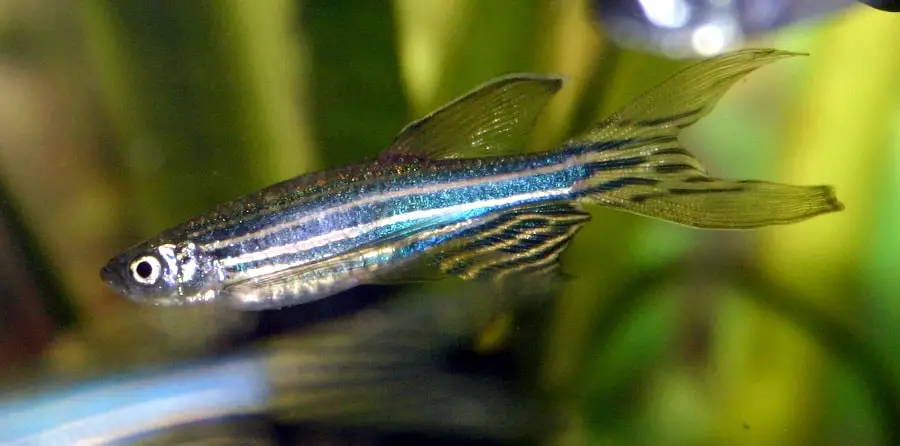
If distinctive horizontal stripes run from the gill down to the tail of a Danio, this means that the fish is a Zebra Danio. Zebra Danios are available in different vibrant colors like black, pink, blue, golden, etc., and even Albino Zebra Danios are present. A variation with leopard-like spots is also a family of the Zebra Danios. Zebra Danio can comparatively stand cooler temperatures.
- Scientific Name: Danio rerio
- Common Name: Striped Danio, Zebra Fish
- Max Size: 2 inches (6 cm)
- Lifespan: 5 years
- Minimum Tank Size requirement: 10 gallon
- pH level: 6.5 – 7.0
- Hardness: 5-12°dGH
- Temperature: 64-74°F (18-24°C)
- Tankmates: Can be kept with nonaggressive species
Giant Danio
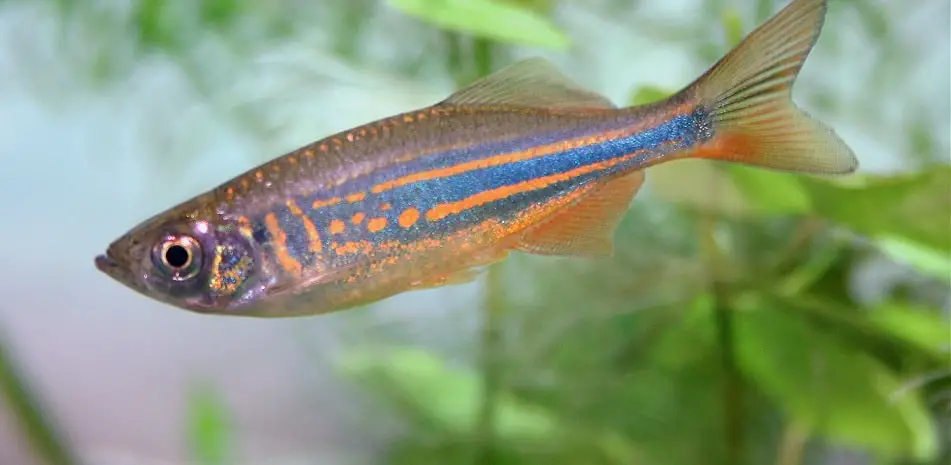
As the name suggests, Giant Danios are larger in size. Usually, Danios length around 2.5 inches, whereby the Giant Danio is around 4 inches when fully grown. Therefore, space is a significant factor to consider.
- Scientific Name: Devario aequipinnatus
- Max Size: 4 inches (10 cm)
- Lifespan: >5 years
- Minimum Tank Size requirement: 30 gallon
- pH level: 6.8-7.5
- Hardness: 20°dGH
- Temperature: 72-75°F (22-24°C)
- Tankmates: Can be kept with larger fish
Rose Danio
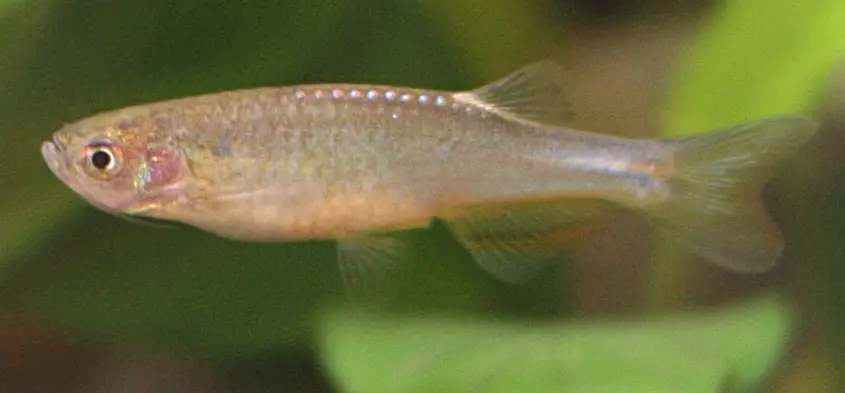
Rose Danio shows off a pearly rose color and gleaming purple-blue in sunlight. It is a popular “Danio” species. It looks familiar to pearl Diano but without the orange stripe on the side.
- Scientific Name: Danio roseus
- Common Name: Purple Haze Danio, Rose Danio
- Max Size: 1.25 inches (3.2 cm)
- Lifespan: 4 years
- Minimum Tank Size requirement: 20 gallon
- pH level: 6.0 – 7.5
- Hardness: 2-15°dGH
- Temperature: 68-77°F (20-25°C)
- Tankmates: Suitable for any small peaceful species
White Cloud Mountain Minnow
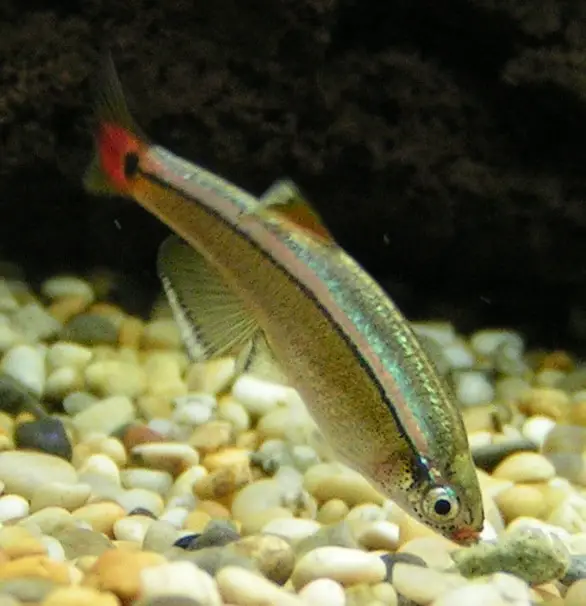
If you want a neon Tetra on a budget, then the White Cloud Mountain Minnow is the right fish. It’s not hard to see what attracts aquarists to this specimen. White Clouds are very easy to maintain and like a cool temperature. This species is now said to be rarely found in its original habitat.
- Scientific Name: Tanichthys alboneubes
- Max Size: 1.5 inches (4 cm)
- Lifespan: 5+ years
- Minimum Tank Size requirement: 10 gallon
- pH level: 6.0 – 8.0
- Hardness: 5-20°dGH
- Temperature: 64-72°F (18-22°C)
- Tankmates: Suitable for any small peaceful fish
Spotted Danio
Dark environments and planted tanks are what Spotted Danios prefer. These small-sized fish reflect a stunning pattern and live in a community. They are very suitable for small-sized containers.
- Scientific Name: Danio nigrofasciatus
- Common Name: Dwarf Danio, Spotted Brown, Spotted Danio
- Max Size: <2 inches (4.5 cm)
- Lifespan: 3 years
- Minimum Tank Size requirement: 10 gallon
- pH level: 6.5-7.0
- Hardness: 5 – 12°dGH
- Temperature: 74-82° F (24-28°C)
- Tankmates: Only small fish are compatible
Pearl Danio

Pearl Danios are hardy fish that can thrive in a wide range of environments. These beautiful pearly blue-violet hued species need to be accompanied by a school.
- Scientific Name: Danio albolineatus
- Common Name: Spotted Danio
- Max Size: 2 inches (6 cm)
- Lifespan: 5 years
- Minimum Tank Size requirement: 20 gallon
- pH level: 6.5 – 7.0
- Hardness: 5-12°dGH
- Temperature: 64-74°F (18-24°C)
- Tankmates: compatible with all species (usually smaller ones)
Glowlight Danio
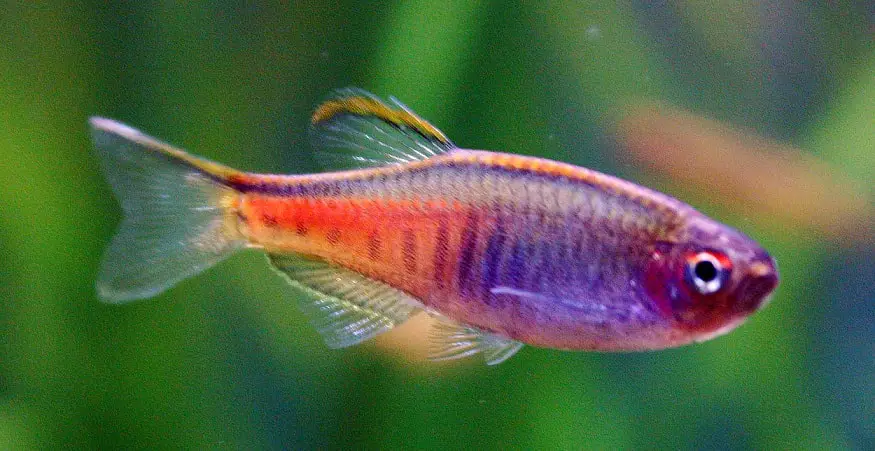
The Glowlight Danio is a bright-colored fish. Adorned with bars, stripes, and spots in radiant colors of green, gold, red, and turquoise, it is completely different from the GloFish.
- Scientific Name: Danio choprai
- Max Size: 2 inches (6 cm)
- Lifespan: 5 years
- Minimum Tank Size requirement: 20 gallon
- pH level: 6.5 – 7.0
- Hardness: 5-12°dGH
- Temperature: 64-74°F (18-24°C)
- Tankmates: compatible with all species (usually smaller ones)
Malabar Danio

Malabar Danio is a peaceful fish originating from Asia. This fish is comparatively larger in size.
- Scientific Name: Devario malabaricus
- Max Size: 4.5 inches (11.9 cm)
- Lifespan: 5 years
- Minimum Tank Size requirement: 30 gallon
- pH level: 6.5 – 7.5
- Hardness: 25°dGH
- Temperature: 64-74°F (18-24°C)
- Tankmates: compatible with all species
Gold Ring Danio
Gold Ring Danio is a tiny fish whose body and fins are covered with blue and gold spots. This is a newly discovered, vibrant genus of danios.
- Scientific Name: Danio tinwini
- Max Size: .67 inches (2.17 cm)
- Lifespan: 3-5 years
- Minimum Tank Size requirement: 20 gallon
- pH level: 6.5 – 7.5
- Hardness: 5-19°dGH
- Temperature: 68-77°F (20–25 °C)
- Tankmates: compatible only with smaller species
Bengal Danio

The Bengal Danio is a subtropical fish that can grow pretty big. They like to be in a school and can tolerate more water conditions than other Danio.
- Scientific Name: Devario devario
- Max Size: 3.9 inches (10 cm)
- Lifespan: 3-5 years
- Minimum Tank Size requirement: 30 gallon
- pH level: 6.5 – 7.5
- Hardness: 5-19°dGH
- Temperature: 68-77°F (18-24°C)
- Tankmates: compatible with all species
These are the ten commonly found Danios among all the other Danio fish, along with their requirements.
Conclusion
Danios are iconic fish that are comparatively easy to handle. Danio can light up your tank by making it look fancy. These low cost and low maintenance factor make Danio fish are the right choice for beginners.
For more detailed aquarium setup, check out my article on the Freshwater aquarium checklist.
I hope this article showed you a briefing on how may Danios there are present and how you can take care of Danios.
Reference
Image Credit
- https://en.wikipedia.org/wiki/en:Creative_Commons
- https://creativecommons.org/licenses/by-sa/3.0/deed.en


